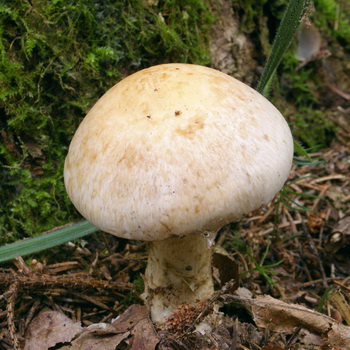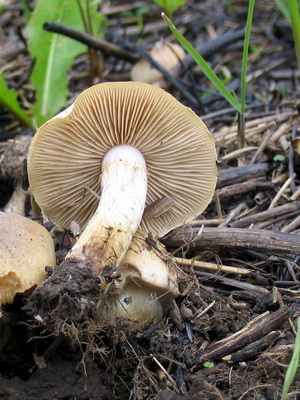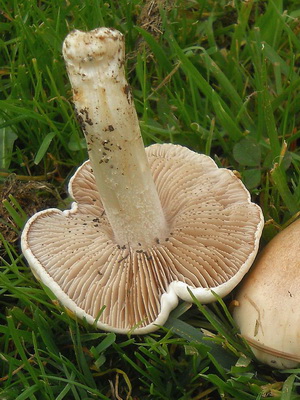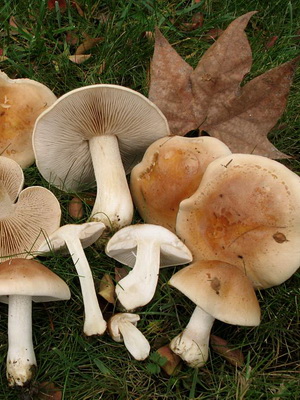Description of coal-loving gebeloma
The diameter of the cap of this small mushroom does not exceed 1-2 centimeters. Its shape changes over time: in young mushrooms, the caps look like a hemisphere, but as they grow, they become almost flat.

The surface of the cap is bare, slimy, with a sticky base. In the center of the cap there is a tubercle of yellow-brown color, and the edges are often lighter - a whitish shade. The leg height is 2 to 4 centimeters. The leg is very thin, no more than 0.5 centimeters in diameter. The shape of the leg is cylindrical, its lower part is slightly thickened, but sometimes there may be no thickening at all. The leg is entirely covered with a stubby bloom of a light ocher color. At the base there is a thin vegetative body of the fungus with a fluffy structure.
The pulp is white, the pulp has a pleasant smell, and the taste is bitter. Spores are lemon-shaped or almond-shaped. The plates are dirty brown in color, at the edges they are noticeably lighter, almost white. Almond-shaped spores. Spore powder of tobacco-brown color.
Unlike its counterparts, the coal-loving gebeloma does not have pronounced remnants of the veil.
Places of growth of coal-loving gebeloma
These mushrooms bear fruit in August. Coal-loving Gebeloma is a carbophilic fungus, so it grows on coals and burns left over from forest fires or bonfires, which is where the name comes from.

Gebeloma coal-loving is widespread in Europe and Asia, it is also found in Tatarstan, Madagascar region and Khabarovsk Territory.
The danger of coal-loving gebeloma
Coal-loving Gebeloma is a poisonous fungus, it causes serious poisoning. It is easy to confuse it with other types of gebel, which are considered conditionally edible. To avoid the possibility of dangerous poisoning, it is better not to collect any gebelomas at all.
Other mushrooms of this genus
Gebeloma belted or brown-mediated has a cap diameter of 4-9 centimeters. The shape of the cap can be from broadly conical to almost flat with a tubercle in the center. The surface of the cap is slightly sticky. The color is chestnut brown, but towards the edges it becomes noticeably lighter. The height of the leg is 4-7 centimeters, and the diameter ranges from 0.5 to 1 centimeter. The leg shape can be straight or curved. The leg is hollow inside. Its color is whitish, while the lower part is brown.

Gebeloma belted forms mycorrhiza with different types of trees and grows in forests of different types. These mushrooms can often be found under birch trees in gardens and parks, as well as at the site of fires. Belted Gebeloma is an edible species, but it is not worth collecting as it is very easy to confuse with other poisonous Gebelomas.
A sticky gebeloma, or a horseradish mushroom, or a crusty gebeloma, or a false valui has a cap with a diameter of 3-10 centimeters. The color of the cap is yellow-brown, and the central part is darker. At first, the shape of the cap is cushion-shaped, and then it becomes flat with a wide tubercle.
Young caps are slimy and then smooth and dry. The cap color ranges from off-white to hazel, sometimes brick red. The height of the flaky-scaly leg is 3-10 centimeters, with a diameter of 1-2 centimeters. At first, the color of the leg is whitish, and later becomes yellowish. Sometimes the stem expands towards the base. At a young age, the leg is solid, but with aging it becomes hollow.
Hebelomas grow in sticky groups, they are found under aspen, oak and birch trees. They bear fruit from September to November. These mushrooms are widespread in the European part of Russia, Central Asia and the Far East. It is an inedible mushroom, and in some sources it is noted as poisonous.

Distinctive features of hebeloma adhesive
The diameter of the cap is 4-9 centimeters.Initially, the shape of the cap is hemispherical, but after a while it becomes rounded-conical, with the edges tucked up, after which the cap opens completely and becomes flat.

The surface of the cap is slightly uneven; a small tubercle is visible in the central part. The skin of the cap is smooth and slightly sticky. In mature specimens, the caps dry out, and the mucus disappears. The color of the cap is yellow-brown. The edges of the cap are lighter.
The pulp is soft enough, white in color. She has an unpleasant smell, reminiscent of radish or raw potatoes, and the taste is bitter. The plates are arranged frequently. At first they are white, and then they become ocher or gray-brown. The edges of the plates are always lighter. Sometimes, small transparent droplets can be seen on the plates. This clear liquid contains mature pores that give dark spots when dry. The shape of the spores is almond-shaped. The color of the spore powder is ocher brown.
The leg height is 3-8 centimeters, and the diameter is 1-2 centimeters. The leg is cylindrical in shape, at the base it can be thickened. In mature specimens, the legs are hollow inside. The color of the leg is white or yellow-brown. The upper part of the leg is covered with a coating that can be easily erased.

Variability of hebeloma sticky
The peculiarity of this mushroom is that the color of its cap can change from off-white to nutty and even brick-red.
Places of growth of hebeloma sticky
They are quite common mushrooms that can be found under oak, birch and aspen trees. They grow on forest edges, fields, meadows and along roads. They are widespread in the northern temperate zone.
Most often, hebelomas grow in groups, often they can form rings. They bear fruit from August to November. And in places with warm winters, glue can be found even in the winter months.
Gebeloma
Mushrooms - Gebeloma
Gebelomas are cap-pedunculated mushrooms belonging to the stropharia family. Until recently, taxonomically, this genus of fungi was mistakenly attributed to other families of fungi: cobweb or bolbitium.
This genus includes several types of mushrooms. At the same time, some gebelomas are conditionally edible or inedible, and some are poisonous. Experienced mushroom pickers, having discovered these mushrooms, do not pay attention to them, because they have no practical value.
These mushrooms grow everywhere: on the soil, on rotten wood, in the places of former fireplaces. Fruiting in August-November.
Botanical description
Gebelomas belong to the cap-pedunculate fungi: their fruiting body consists of a cap and a leg. The Gebelom cap is flat or hemispherical, with a smooth or scaly shell of white or brown color. The diameter of the different species of these mushrooms ranges from 3 to 9 cm. On the underside of the cap there are attached light or brown plates. Spore powder is colored with different shades of brown.
The cylindrical fibrous stems are located centrally in relation to the cap. The inside of the leg can be hollow, and on top it is often covered with scales. On the stem closer to the cap, many representatives of this genus have a spider-like or filmy ring.
The flesh of the mushroom is fleshy, firm, white or brown in color, and tastes bitter. On the cut, the pulp does not change its color and exudes a strong specific aroma, similar to the smell of a radish.
Species differences
The genus Gebelome includes several dozen species. The most common of them on the territory of Russia are the types: sticky, mustard, root, inaccessible, belted and coal-loving.
Hebeloma sticky
Mushrooms of this species are the most common gebelomas in our country. Russian mushroom pickers call them "horseradish mushrooms" or false values, and in England they are called "fairy cake" or "poisonous cake". They are referred to as inedible, and in some literary sources - to poisonous mushrooms.
False value hats are yellow-brown, sticky in young and dry in mature individuals.The size of the caps of some specimens reaches 10 cm. On the back of the caps in humid weather, moisture accumulates on the plates, which, after drying, gives them a spotty color. The pulp is light brown with a sharp rare odor and bitter taste.
Mushrooms of a sticky species grow in groups on forest edges, glades, along roads. Distributed throughout the European part of Russia, in the Far East, in Central Asia.
Mustard Hebeloma
It is a poisonous species of Gebelom. Their name comes from the fact that when ripe, the plates on the back of the caps acquire a mustard color.
Their caps have wavy edges. In size, they can reach 15 cm. The color of the caps varies from cream to brown-red, while the edges are colored lighter than the center. The spore powder has a bright orange color.
The legs are hollow inside; on a longitudinal section in their upper part, you can see the connection between the cavities inside the cap and the leg. The legs are covered with scales in such a way that they create a ring pattern on them.
Coniferous and deciduous forests are a favorite growing place for mustard gebelom. They grow in numerous groups.
Root Gebeloma (tapered)
These representatives of the Gebelom genus are conditionally edible: some cooks cook them together with edible mushrooms. The legs of the root gebelom are half submerged in the soil, creating a semblance of a root. Because of this feature, mushrooms of the root species got their name.
Their caps are large (up to 15 cm in diameter), hemispherical, light brown in color. The surface of the cap is covered with darker scales, resulting in a pockmarked appearance. The plates are semi-adherent, colored in different shades of gray and brown, while in young specimens they are lighter than in mature ones. The pulp is dense, light, has a bitter taste and an almond smell.
They love to grow in deciduous forests, because they form mycorrhiza with deciduous trees. Most often they can be found in places with a bald topsoil: in pits, ditches, near burrows.
Gebeloma inaccessible
It is a poisonous mushroom. Has a hat with a diameter of 4 to 8 cm with an indentation in the center. The surface of the cap is slimy, reddish in color, with a wavy edge. The plates are wide, with light margins. The pulp has a bitter taste and a pronounced radish smell. The leg is covered with scales, thickened at the base.
They grow on moist soils of coniferous, deciduous and mixed forests, abandoned gardens, rarely visited corners of parks and squares. Ripen in August-September.
What does Hebeloma sticky look like?
The diameter of the gummy cap can be from 3 to 10 cm. Its color is yellowish-brown, with a noticeable darkening in the center. In young fruiting bodies, it has a convex cushion shape. With age, its surface flattens, a wide tubercle rolls over it.
At an early age, the cap is covered with mucus, over time it becomes dry and shiny. Depending on external factors, the color can vary from grayish to reddish brown. The edges of the cap are slightly bent.
Instances of hebeloma sticky of different ages
The leg has a cylindrical shape. Its diameter is 1-2 cm, and the length is from 3 to 10 cm. At first it is white, but with age it becomes yellowish, then brown. In addition, in mature specimens, the leg is noticeably thickened from below. Inside it is hollow, the outer covering is scaly.
The hymenophore is lamellar, its color is the same as that of the leg: at first it is whitish, over time it becomes yellow or brown. The plates have small indentations on which droplets of liquid form in wet weather. It is brown due to the presence of spores.
Drying liquid causes the hymenophore to darken.
The pulp is white; in old specimens of gummy hebeloma, it is yellowish. Its layer is thick and the consistency is loose. The taste of the pulp is bitter, the smell is pungent, reminiscent of a radish.
Mushroom spread
Distributed almost everywhere - in coniferous, deciduous and mixed forests of Eurasia.
Similar species
Similar to some other members of the same genus:
This is a dangerous poisonous mushroom.It features a flat cap with an indentation in the center. The color is reddish, with age it becomes lighter. The leg is often not straight, but curved in several places at once, twisted. The pulp also smells like radish and tastes bitter.
It is also a venomous species. Has a dense, fleshy cap that can be cone-shaped or flat. Painted in brown, red or cream tones. The pulp of the leg is fibrous, the surface is covered with scales.
It differs in smaller sizes (the diameter of the cap is up to 2 cm, the height of the leg is up to 4 cm). Marked as inedible.
Edibility
Many sources identify the mushroom as edible. However, it is not recommended for consumption, since it is rather difficult to distinguish the girdle girdle from similar poisonous varieties. In addition, the taste of this mushroom has bitter shades, in part resembles a radish.
Interesting Facts
Gebeloma often grows in city parks. Sometimes she can even settle in a conflagration. Usually found in relatively large groups rather than solitary mushrooms. There was no consensus in determining the systematic position of this fungus. Some scientists attribute it to a separate species, while others - to a species complex, which includes several varieties.
Where does hebeloma sticky grow
Distributed in the temperate climate of the Northern Hemisphere throughout Europe and Asia - from the Bay of Biscay to the Far East. It is ubiquitous in Canada and the northern United States. It can be found in both the extreme northern and southern regions. Cases of finding mushrooms in the regions of the Arctic Circle and in the south of Central Asia were recorded. It was listed in Australia. Not found in Africa and South America.
It grows in both coniferous and deciduous forests. It can be found in glades, meadows, glades, in parks. Despite the fact that it forms mycorrhiza with all types of trees, prefers deciduous conifers - oak, birch, aspen. The nature of the soil, as well as its moisture or shade of the area, do not play a role.
Fruiting occurs in late summer and lasts until November. In regions with warm winters, the fungus is found even in December and January. Often forms rings.
Poisoning signs and first aid

The substances that are contained in the pulp of this mushroom are toxic to the human body, but they have not yet been identified and very poorly studied. But it is indisputable that their toxicity is very high.
The poisonous substances contained in the pulp of this mushroom have a significant negative effect on the human digestive system. The first symptoms of poisoning appear very quickly, after a short period of time after eating hebeloma:
- loose stools;
- nausea and vomiting;
- colic.
It is noted: respiratory failure, headaches, thirst, in severe cases - paralysis of the limbs. If a person feels at least one of the signs of mushroom poisoning, then immediately call an ambulance.
First aid to the victim is to cleanse the digestive tract of fungal toxins that have not yet been absorbed into the bloodstream. Usually, for this, the stomach is washed with boiled water or activated charcoal. And in any case, they call a team of doctors at home.
Sticky Gebeloma is a mushroom you shouldn't mess with. You can get to the hospital with poisoning by this "gift" of the forest very quickly. Fortunately, it is very easy to distinguish Gebeloma from other species due to its smell, so if the mushroom you cut has a sharp and unpleasant aroma, then it is better to throw it aside and move on.
Literature
- Mushrooms: Handbook / Per s ital F Dvin - M: "Astrel", "AST", 2001 - C 157 - ISBN 5-17-009961-4
- Lesso T Mushrooms, key / translation from English L V Garibova, SN Lekomtseva - M: "Astrel", "AST", 2003 - C 67 - ISBN 5-17-020333-0
- Harding P Mushrooms / Translated from English by DS Shchigel - M: "Astrel", "AST", 2002 - C 127 - ISBN 5-17-011765-5
- Nilsson, S & Persson, O 1977 Fungi of Northern Europe 2: Gill Fungi Penguin Books eng
- Phillips R Mushrooms of North America - Little, Brown & Co, 1991 - ISBN ISBN eng
- Serzhanina GI Hat mushrooms of Belarus - Minsk: Science and technology, 1984
Gebeloma adhesive paper, Gebeloma adhesive tape, Gebeloma adhesive film
Distinctive signs of hebeloma inaccessible
The cap of the fruiting body reaches 8 centimeters in diameter. Its shape is outstretched, and the center is dented. The surface of the cap is slimy. The edges of the cap are fluffy, fibrous. The color of the cap is reddish, but over time it fades and becomes whitish.
The pulp of the mushroom has a bitter taste and a rare smell. The color of the pulp is whitish. The plates are sparse, wide, with white edges.
The leg is thickened at the base. It often twists. At the top, the leg is strewn with white scales. The height of the leg is 6-10 centimeters, with a diameter of 1.5-2 centimeters. There is a subtle, flaky ring on the stem.

The spread of hebeloma is inaccessible
These mushrooms inhabit all floristic zones of our country, in the Far East and Siberia. These mushrooms grow on moist soils. They can be found in various types of forests, as well as in parks or gardens. Gebelomas are inaccessible from August to September.
Assessment of hebeloma is not available
Gebeloma is inaccessible - a poisonous mushroom. These mushrooms contain a poisonous substance that provokes significant disorders. Most people recover in 2-3 days, but in rare cases, death occurs.
In case of poisoning with inaccessible gebeloma, nausea occurs, vomiting opens, and cardiac activity is disturbed.
Related species
Mustard gebeloma is a poisonous mushroom. His hat is dense, fleshy, up to 15 centimeters in diameter. At first, its shape is conical, and over time it becomes prostrate. The color is cream or red-brown. The leg is cylindrical, voluminous, and rigid in structure. Its height can reach 15 centimeters. The pulp with a rare odor, dense and fleshy.

Mustard Hebeloma is very common. Harvest time is in summer and autumn. These mushrooms grow in deciduous and coniferous forests, as a rule, on the edges. They live in large groups. These toxic fungi provoke poisoning.
Hebeloma sticky or false false - a poisonous mushroom. The cap of this mushroom reaches 10 centimeters in diameter. Its color is off-white, yellow-brown, hazel or brick-red. At the initial stage of growth, the shape of the cap is cushion-shaped, after which it becomes flat-convex. The surface of the cap is slimy, shiny and smooth. The leg is rather long. Its color is whitish, and then becomes yellowish. Its surface is flaky-scaly. The pulp is thick, friable, at first white, and eventually creamy. Its taste is bitter, and the smell is rare.
These mushrooms grow in groups. They grow under aspen and birch trees. They can be found in clearings, on forest edges, and along the edges of roads. Fruiting time is September-November. These mushrooms are found from the Arctic to Central Asia.
Morphology
Fruiting bodies of cap-peduncles with a central position of the stem, usually of medium size.
The cap is from hemispherical to flat, possibly with a tubercle. The skin is slimy or sticky, less often dry, whitish or brown in color, usually light. The surface is smooth or fibrous, scaly.
The pulp is well developed, fleshy, soft or firm, compact or relatively thin, white or brownish, does not change on the cut, usually bitter and has a strong characteristic odor (sparse or otherwise).
The stem is cylindrical, fibrous, can be hollow, often with a scaly or mealy coating.
The plates are adherent, with a notch or free, at first pale, then light brown.
A private veil, cobweb or filmy, is found in the form of a ring or annular zone on the leg, hanging flakes along the edge of the cap, in many species these signs are vaguely expressed or completely invisible.
Spore powder of brownish-brown shades.
Mushroom false valui (gummy sticky)

In scientific reference books, the false valui is called ghebeloma sticky, and among the people it was dubbed the “shitty mushroom”. Its toxins have characteristic features that give an idea of \ u200b \ u200btoxicity.
Visual photos and descriptions of false value mushrooms will help make a difference from edible species.
What a false value looks like and how to distinguish it from a real one
Latin name: Hebeloma crustuliniforme.
Family: Stropharia.
Synonyms: "horseradish mushroom", false value, crusty gebeloma.


Hat: up to 10 cm in diameter, has a neatly convex shape and turned up edges. In adulthood, the cap bends inward and becomes dense. The surface is smooth but sticky, yellow in color with white edges. Sometimes there are hats with a reddish and even brick tint.
Leg: diameter up to 2.5 cm, height up to 9 cm, white-fawn shade, with a thickening towards the base and a mealy bloom.


Pulp: thick, firm, with a bitter taste and an unpleasant smell of fresh radish. The color of the flesh is creamy or white; in adulthood, the shade becomes darker.
Blades: adherent and often spaced, gray or white in young specimens, brown-yellow with light margins in old fruit chalk. Drops of exudate are visible over the entire surface of the plates, which, when dried, turn black.
Edible: a poisonous mushroom with an unpleasant odor and bitter flesh.
Similarities and differences: Hebeloma sticky or Valuy false has similarities with some poisonous counterparts: Gebeloma coal-loving, Gebeloma girded and Gebeloma mustard.
The belted one is distinguished by a brown cap, as well as a thinner leg.
Mustard is distinguished by its smaller size, sparse plates and a practically non-sticky surface of the cap.
Goebelum sticky mushroom pickers are often confused with edible russula. A distinctive feature is an unpleasant and pungent smell of horseradish gebeloma at the site of a cut or break. Therefore, if you hear an unpleasant aroma while plucking the fruiting body, do not take it under any circumstances.
The information provided will help you see how to distinguish a false value from a real one in order to protect yourself and your loved ones from the negative consequences of using it.
Distribution: grows throughout Russia, preferring moist, light soil on the open edges of deciduous and coniferous forests, as well as on the sides of forest roads. Fruiting time is from mid-August to early November. Prefers to form mycorrhiza with aspen, birch and oak roots. It can be found in the Caucasus, Central Asia and even Australia.
After reading the description of false valuey, and having learned what these mushrooms look like, you can safely go into the forest and collect edible species.
Conclusion
Hebeloma sticky (Valui false) is a weakly poisonous mushroom from the Spiderweb family, found everywhere in the temperate climate of Eurasia and North America. A hardy and unpretentious species spreads from the hot southern regions to the Far North. It is capable of forming mycorrhiza with almost all types of trees and can grow on soils of any composition and acidity.
Mushroom poisoning, according to doctors, is one of the most common in summer and autumn. Moreover, even experienced mushroom pickers often become victims of their own inattention, although usually each poisonous mushroom has peculiarities in its appearance that make it possible to distinguish it from an edible one and not to collect it. So sticky gebeloma - one of the most toxic fungi - has its own characteristic features that allow you to bypass it. How to protect yourself from poisoning with this mushroom?






